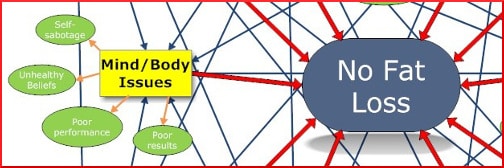 Fat-Loss-Web
Fat-Loss-Web
The distress of being obese must be dreadful. But it’s a form of distress that is familiar and known, while change is difficult and scary. One of the oldest clichés is, “Better the devil you know than the devil you don’t.” Dr. Pretlow has remarked, “A main obstacle seems to be that people really, really don’t want to change, and that applies across the board.”
When a child or teenager considers the idea of entering a weight loss program, feelings will necessarily be mixed. They are being asked to make an extreme change, with no guarantee of increased happiness. Ask a prisoner if he wants to move to a different cell. “But what if it turns out to have mice? What if there is a cold draft I didn’t feel in my old cell?” Change is frightening for a very good reason, because in simple (and not necessarily accurate) emotional arithmetic, there’s always a 50/50 chance that the new regime will be worse than the old one.
What if an expert salesperson wanted to convince you to have an arm removed and replaced with a snazzy, state-of-the-art bionic arm? You will be able to throw a baseball like nobody’s business and never get skin cancer or be bothered by mosquito bites. The fingers will be so muscular you can bring the world’s strongest man to his knees with a handshake. Still, you’d have to think about it, right? Maybe that’s not a good example, because it’s irreversible. At least if someone loses a bunch of weight and then decides they’re not happy about it, they can always go back to being fat.
Unhealthy beliefs
The illustration on this page is part of a much larger chart compiled by Dr. Bryan P. Walsh in 2010 and not surprisingly, the section that applies to mind-body issues is as true as it has been since humans started thinking. The small ovals represent self-sabotage, unhealthy beliefs, poor performance, and poor results.
This is how Dr. Walsh breaks down the basics regarding mental attitude, goal setting, and a person’s ability to shed fat:
Step one is to decide on your goals and figure out what it is that you want in specific and measurable terms… You need to be very clear about what you want and write it down.
Step two is to spend ten minutes every day experiencing yourself as having achieved those goals… The more you experience the feelings associated with achieving a certain goal, the more likely it will happen.
The third step is to determine actionable items that will help you achieve them, and do them.
For a parent, caregiver, or health professional, the attempt to steer a child onto the weight-loss track can be frustrating. The solution seems so obvious – just like when a woman is in a domestic abuse situation. A hundred people could be looking on and saying, “Why doesn’t she get out?” But as we know from numerous movies and TV dramas, which reflect actual case histories, the idea of leaving can be even more frightening than the idea of staying. A hundred people could be saying, “Go ahead, escape, things will be better, you’ll see.” But the subconscious mind, in its tumult and turmoil, is not impressed by logic.
Deep down, a person may have a “reason” for staying obese, because it seems to serve them in some way. It doesn’t have to be rational or correct, or even to make sense. This is about emotional survival, not logic. A belief can be false, unconscious, and dysfunctional, but as long as it lurks somewhere in the psyche, it might as well be true, because it casts an influence. With most people, the reason why they accept being fat is probably unconscious, which is why therapy to address the root cause seems very important. Part of Step #1, the specific definition of personal goals, should include a determination to identify any unhealthy beliefs and extirpate them.
Your responses and feedback are welcome!
Source: “The Missing Fat Loss Manual,” FatIsNotYourFault.com, 2010
Image by Dr. Bryan P. Walsh

 FAQs and Media Requests:
FAQs and Media Requests: 












2 Responses
Do you have thoughts on the importance of exclusive Breastfeeding for obesity avoidance?
“The Many Voices in a Breastfeeding Debate” is one of several posts on the subject. Please enter “breastfeeding” in the search box and you will find more. Thanks for being a Childhood Obesity News reader.